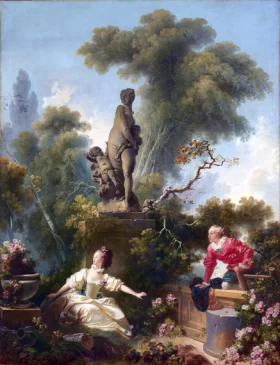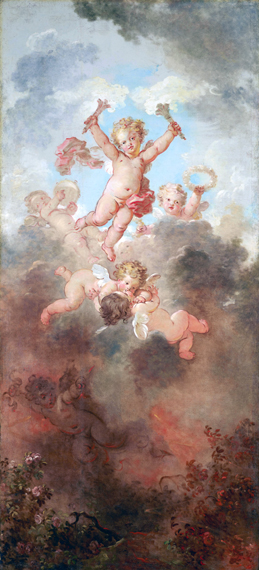5% Off Sitewide | Use code KMUS5 on checkout
- Choose your Country
5% Off Sitewide | Use code KMUS5 on checkout
Jean-Honoré Fragonard
Jean-Honoré Fragonard (French:5 April 1732 – 22 August 1806) was a French painter and printmaker whose late Rococo manner was distinguished by remarkable facility, exuberance, and hedonism. Among his most popular works are genre paintings conveying an atmosphere of intimacy and veiled eroticism.
Fragonard was the son of a haberdasher’s assistant. The family moved to Paris about 1738, and in 1747 the boy was apprenticed to a lawyer, who, noticing his appetite for drawing, suggested that he be taught painting. François Boucher was prevailed upon to accept him as a pupil (c. 1748), and in 1752, Fragonard’s elementary training completed, Boucher recommended that he compete for a Prix de Rome scholarship, which meant study under the court painter to Louis XV, Carle Van Loo, in Paris. On September 17, 1756, Fragonard set off with other scholarship winners for the French Academy at Rome.
While at Rome, Fragonard contracted a friendship with a fellow painter, Hubert Robert. In 1760, they toured Italy together, executing numerous sketches of local scenery. It was in these romantic gardens, with their fountains, grottos, temples and terraces, that Fragonard conceived the dreams which he was subsequently to render in his art. He also learned to admire the masters of the Dutch and Flemish schools (Rubens, Hals, Rembrandt, Ruisdael), imitating their loose and vigorous brushstrokes. Added to this influence was the deep impression made upon his mind by the florid sumptuousness of Giovanni Battista Tiepolo, whose works he had an opportunity to study in Venice before he returned to Paris in 1761.
Hitherto Fragonard had hesitated between religious, classic and other subjects; but now the demand of the wealthy art patrons of Louis XV’s pleasure-loving and licentious court turned him definitely towards those scenes of love and voluptuousness with which his name will ever be associated, and which are only made acceptable by the tender beauty of his color and the virtuosity of his facile brushwork; such works include the Blind Man’s Bluff (Le collin maillard), Serment d’amour (Love Vow), Le Verrou (The Bolt), La Culbute (The Tumble), La Chemise enlevée (The Raised Chemise), and L’escarpolette (The Swing), and his decorations for the apartments of Mme du Barry and the dancer Madeleine Guimard.
He married Marie-Anne Gérard, herself a painter of miniatures, (1745–1823) on 17 June 1769 and had a daughter, Rosalie Fragonard (1769–1788), who became one of his favourite models. In October 1773, he again went to Italy with Pierre-Jacques Onézyme Bergeret de Grancourt and his son, Pierre-Jacques Bergeret de Grancourt. In September 1774, he returned through Vienna, Prague, Dresden, Frankfurt and Strasbourg.
He turned his interests toward a new type of subject matter: domestic scenes inspired by Jean-Jacques Rousseau’s moral philosophy or romantic novels (The Happy Family, c. 1775) or scenes concerned with children’s upbringing, in which his son Évariste (born 1780) frequently figures (The Schoolmistress [“Now Say Please”], c. 1780).
In the last years preceding the French Revolution, Fragonard turned finally to Neoclassical subject matter and developed a less fluent Neoclassical style of painting (The Fountain of Love, c. 1785), which becomes increasingly evident in his later works, particularly the genre scenes executed in collaboration with Marguerite Gérard (The Beloved Child, 1780–85).
The French Revolution deprived Fragonard of his private patrons: they were either guillotined or exiled. The neglected painter deemed it prudent to leave Paris in 1790 and found shelter in the house of his cousin Alexandre Maubert at Grasse, which he decorated with the series of decorative panels known as the Les progrès de l’amour dans le cœur d’une jeune fille, originally painted for Château du Barry.
At first he retired to Grasse, but he returned to Paris in 1791, where the protection of the leading Neoclassical painter Jacques-Louis David obtained for him a post with the Museum Commission, but he lost this position in 1797. He spent the rest of his life in obscurity, painting little. His death in 1806 passed almost unnoticed, and his work remained unfashionable until well after 1850.
Fragonard has been bracketed with Watteau as one of the two great poetic painters of the 18th century in France. A prodigiously active artist, he produced more than 550 paintings, several thousand drawings (although many hundreds are known to be lost), and 35 etchings. His style, based primarily on that of Rubens, was rapid, vigorous, and fluent, never tight or fussy like that of so many of his contemporaries.
A rediscovered painting, Philosopher Reading by Jean-Honoré Fragonard sold at auction for €7.7 million ($9.2 million) with buyer’s premium at the Enchères Champagne auction house on Saturday in Épernay, France. The result was more than three times its $2.4 million high estimate.
Read moreShowing 1–100 of 130 results

Les Hasards Heureux De L’escarpolette (The Swing)
By Jean-Honoré FragonardSizes starting at $379.00
Blind-Mans Buff
By Jean-Honoré FragonardSizes starting at $379.00
The Love Letter
By Jean-Honoré FragonardSizes starting at $319.00
Young Girl Reading 1770
By Jean-Honoré FragonardSizes starting at $339.00
The Stolen Kiss
By Jean-Honoré FragonardSizes starting at $379.00
Le Verrou The Bolt 1777
By Jean-Honoré FragonardSizes starting at $389.00
Jeroboam Sacrificing to the Idols, 1752
By Jean-Honoré FragonardSizes starting at $389.00
Grand Priest Coresus Sacrifices himself to save Callirhoe 1765
By Jean-Honoré FragonardSizes starting at $389.00
The Progress of Love- The Pursuit
By Jean-Honoré FragonardSizes starting at $429.00
The Progress of Love- The Meeting
By Jean-Honoré FragonardSizes starting at $389.00
The Progress of Love- The Lover Crowned
By Jean-Honoré FragonardSizes starting at $389.00
The Progress of Love- Love Letters
By Jean-Honoré FragonardSizes starting at $409.00
The Progress of Love- Love Triumphant
By Jean-Honoré FragonardSizes starting at $569.00
The Progress of Love- Reverie
By Jean-Honoré FragonardSizes starting at $359.00
The Progress of Love- Love Pursuing a Dove
By Jean-Honoré FragonardSizes starting at $319.00
The Progress of Love- Love the Avenger
By Jean-Honoré FragonardSizes starting at $309.00
The Progress of Love- Love the Jester
By Jean-Honoré FragonardSizes starting at $309.00
The Progress of Love- Love the Sentinel
By Jean-Honoré FragonardSizes starting at $309.00
A Game of Horse and Rider
By Jean-Honoré FragonardSizes starting at $389.00
A Game of Hot Cockles
By Jean-Honoré FragonardSizes starting at $379.00
The Swing
By Jean-Honoré FragonardSizes starting at $359.00
Blindman’s Buff
By Jean-Honoré FragonardSizes starting at $339.00
The See-Saw
By Jean-Honoré FragonardSizes starting at $379.00
Blindman’s Buff
By Jean-Honoré FragonardSizes starting at $399.00
The Musical Contest
By Jean-Honoré FragonardSizes starting at $359.00
Happy Lovers
By Jean-Honoré FragonardSizes starting at $399.00
The Shepherdess
By Jean-Honoré FragonardSizes starting at $399.00
The Fête at Saint Cloud
By Jean-Honoré FragonardSizes starting at $449.00
The Joys of Motherhood 1752
By Jean-Honoré FragonardSizes starting at $409.00
The Reaper
By Jean-Honoré FragonardSizes starting at $379.00
The Grape Gatherer 1754
By Jean-Honoré FragonardSizes starting at $389.00
The Gardener
By Jean-Honoré FragonardSizes starting at $349.00
The Shepherdess
By Jean-Honoré FragonardSizes starting at $349.00
The Pre-arranged Flight
By Jean-Honoré FragonardSizes starting at $319.00
The Angora Cat
By Jean-Honoré FragonardSizes starting at $309.00
The Souvenir
By Jean-Honoré FragonardSizes starting at $319.00
La Surprise
By Jean-Honoré FragonardSizes starting at $319.00
A Philosopher Reading
By Jean-Honoré FragonardSizes starting at $319.00
The Philosopher
By Jean-Honoré FragonardSizes starting at $389.00
The Bathers 1765
By Jean-Honoré FragonardSizes starting at $399.00
A lady and her maid chastising a spaniel
By Jean-Honoré FragonardSizes starting at $349.00
The Young Erudite Mother
By Jean-Honoré FragonardSizes starting at $359.00
Psyche showing her Sisters her Gifts from Cupid
By Jean-Honoré FragonardSizes starting at $379.00
The Beloved Child
By Jean-Honoré FragonardSizes starting at $379.00
The First Steps
By Jean-Honoré FragonardSizes starting at $379.00
The Stolen Kiss 1760
By Jean-Honoré FragonardSizes starting at $419.00
The High Priest Coresus Sacrificing Himself to Save Callirhoe 1765
By Jean-Honoré FragonardSizes starting at $429.00
In the Wheat (Dans les blés)
By Jean-Honoré FragonardSizes starting at $409.00
The Laundresses
By Jean-Honoré FragonardSizes starting at $389.00
The Fountain of Love 1785
By Jean-Honoré FragonardSizes starting at $359.00
The goddess Aurora triumphs over night, Apollo in his chariot, Morpheus sleeps
By Jean-Honoré FragonardSizes starting at $389.00
Diana and Endymion
By Jean-Honoré FragonardSizes starting at $409.00
The goddess Aurora triumphing over Night
By Jean-Honoré FragonardSizes starting at $409.00
Céphale et Procris 1755
By Jean-Honoré FragonardSizes starting at $589.00
Jupiter sous les traits de Diane, séduisant Callisto
By Jean-Honoré FragonardSizes starting at $599.00
Dites donc s’il vous plaît (Say Please)
By Jean-Honoré FragonardSizes starting at $389.00
The Visit to the Nursery 1775
By Jean-Honoré FragonardSizes starting at $399.00
Young Washerwomen
By Jean-Honoré FragonardSizes starting at $399.00
Roman Interior 1760
By Jean-Honoré FragonardSizes starting at $319.00
A Young girl sleeping
By Jean-Honoré FragonardSizes starting at $389.00
The Desired Moment 1770
By Jean-Honoré FragonardSizes starting at $379.00
Education is Everything
By Jean-Honoré FragonardSizes starting at $329.00
Girl with dog
By Jean-Honoré FragonardSizes starting at $339.00
Two girls on a bed playing with their dogs
By Jean-Honoré FragonardSizes starting at $339.00
The Two Sisters
By Jean-Honoré FragonardSizes starting at $319.00
Le Billet Doux (The Love Letter)
By Jean-Honoré FragonardSizes starting at $329.00
Les Baisers Maternels
By Jean-Honoré FragonardSizes starting at $319.00
Les Curieuses
By Jean-Honoré FragonardSizes starting at $319.00
Music
By Jean-Honoré FragonardSizes starting at $489.00
Winter 1755
By Jean-Honoré FragonardSizes starting at $459.00
Landscape with Shepherds and Flock of Sheep 1763
By Jean-Honoré FragonardSizes starting at $339.00
Le petit parc (The small park)
By Jean-Honoré FragonardSizes starting at $319.00
Le Tertre
By Jean-Honoré FragonardSizes starting at $319.00
The Pond
By Jean-Honoré FragonardSizes starting at $319.00
Barquant dans un parc
By Jean-Honoré FragonardSizes starting at $329.00
A wooded landscape with milkmaids and their cattle sheltering from a shower
By Jean-Honoré FragonardSizes starting at $319.00
La mare
By Jean-Honoré FragonardSizes starting at $319.00
Landscape with Passing Shower
By Jean-Honoré FragonardSizes starting at $319.00
Family of Shepherds in a family landscape
By Jean-Honoré FragonardSizes starting at $319.00
Pastoral landscape with a shepherd and shepherdess at rest
By Jean-Honoré FragonardSizes starting at $349.00
The Isle of Love 1770
By Jean-Honoré FragonardSizes starting at $339.00
The Rock
By Jean-Honoré FragonardSizes starting at $309.00
The Watering Place 1765
By Jean-Honoré FragonardSizes starting at $319.00
A shepherd and herdsman seated on a rock with cows and sheep, a landscape beyond
By Jean-Honoré FragonardSizes starting at $319.00
Paysage italien agrave
By Jean-Honoré FragonardSizes starting at $319.00
A wooded landscape with brigands attacking travellers
By Jean-Honoré FragonardSizes starting at $319.00
Return of the Drove
By Jean-Honoré FragonardSizes starting at $319.00
A wooded landscape with figures at the edge of a pond
By Jean-Honoré FragonardSizes starting at $329.00
Mountain Landscape at Sunset 1765
By Jean-Honoré FragonardSizes starting at $359.00
Grand Cascade at Tivoli
By Jean-Honoré FragonardSizes starting at $319.00
The Cascade
By Jean-Honoré FragonardSizes starting at $319.00
A Shaded Avenue 1775
By Jean-Honoré FragonardSizes starting at $319.00
A Boy in a Red-lined Cloak
By Jean-Honoré FragonardSizes starting at $319.00
A Boy as Pierrot 1785
By Jean-Honoré FragonardSizes starting at $309.00
A little boy with a curiosity
By Jean-Honoré FragonardSizes starting at $329.00
A Young Woman Leaning out of a Window
By Jean-Honoré FragonardSizes starting at $319.00
Girl reading a book
By Jean-Honoré FragonardSizes starting at $309.00
Inspiration 1769
By Jean-Honoré FragonardSizes starting at $319.00
Jérôme de La Lande
By Jean-Honoré FragonardSizes starting at $319.00
Portrait of François-Henri d’Harcourt 1769
By Jean-Honoré FragonardSizes starting at $319.00




































































































